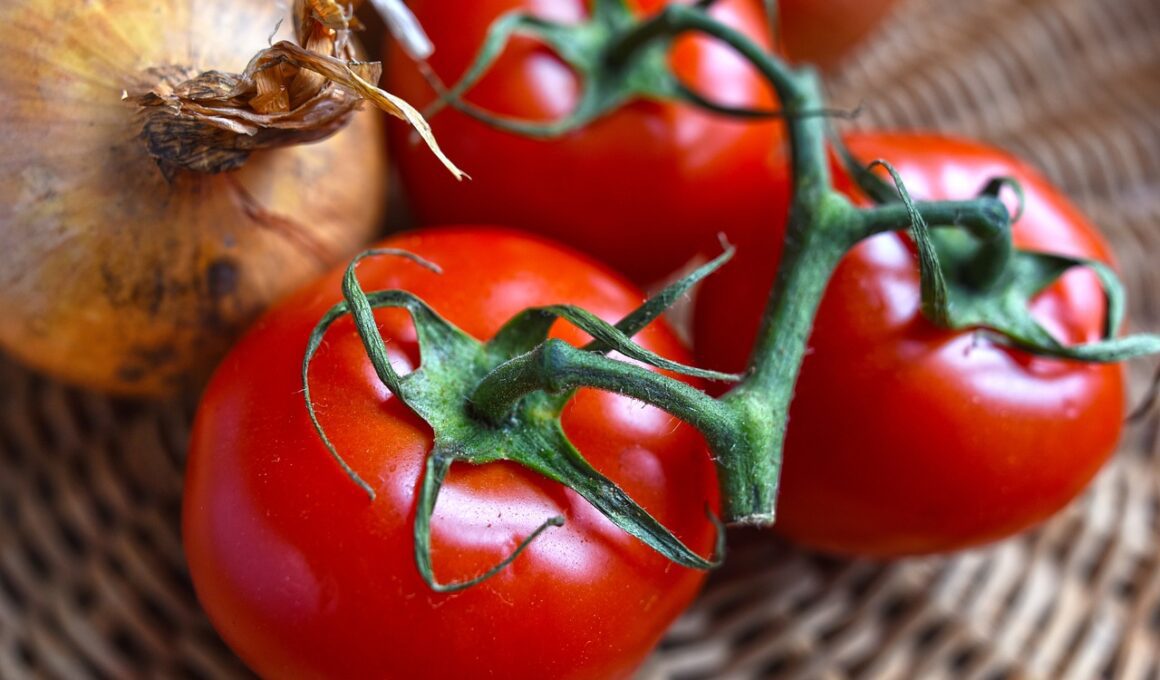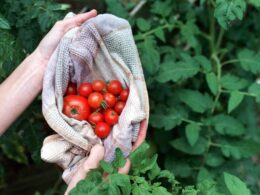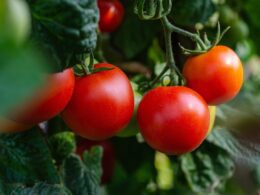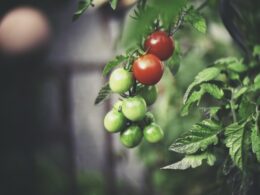Are you a tomato enthusiast looking for ways to ensure a bountiful harvest? You might’ve wondered if it’s possible to self-pollinate your tomato plants. Fear not, as this article is here to help answer that question while providing valuable information on how to achieve the best results.
In this article, we’ll delve into understanding tomato pollination and the factors that affect self-pollination. We’ll also discuss techniques for encouraging self-pollination and weigh the benefits and drawbacks of doing so.
Finally, we’ll share some helpful tips for maximizing your tomato plant’s health and productivity, giving you peace of mind knowing you’re on your way to a safe and successful growing season.
Understanding Tomato Pollination
It’s crucial to grasp how tomato plants are pollinated, as this vibrant dance of nature ensures a bountiful harvest.
Tomato flowers contain both male and female parts, known as the stamen and pistil respectively. The pollen from the stamen must reach the pistil for fertilization to occur, leading to fruit development.
In many cases, tomatoes can be self-pollinating because their flowers have all the necessary parts for reproduction.
One factor that plays a significant role in successful tomato pollination is vibration. As wind or insects like bees visit your tomato plants, they cause vibrations that encourage the release of pollen from the stamens onto the pistils. This process is essential for fertilization and fruit production.
While some gardeners may rely on Mother Nature to provide adequate wind or insect activity, others might choose to give their tomato plants a little extra help with hand-pollination techniques like gently shaking or tapping their plant’s branches.
Although you may be tempted to intervene in your tomato plant’s pollination process, it’s important to remember that nature often takes care of things without any human intervention needed.
If you’re growing tomatoes in an area with good airflow and a healthy ecosystem of pollinators like bees and butterflies, chances are high that your plants will produce plenty of tasty fruits for you to enjoy all season long.
Just keep an eye on your plants’ health and growth, make sure they receive proper care such as water and nutrients, and trust that nature will work its magic when it comes to successful tomato pollination.
Factors Affecting Self-Pollination
As you dive into the world of self-pollination, it’s crucial to consider three key factors that play a significant role in this process. These elements can greatly impact your plants’ ability to successfully self-pollinate and produce bountiful crops.
The three factors to consider are environmental conditions, plant health, and genetics. Understanding how these factors interact with one another will help you achieve the best results in your garden.
So, make sure to pay close attention to the health of your plants, the conditions in which they are growing, and their genetic makeup. By doing so, you can greatly increase the chances of successful self-pollination and a bountiful harvest.
Environmental Conditions
In the right environmental conditions, those lovely red gems are able to pollinate themselves, making our gardening tasks a bit easier! However, it’s essential to provide an environment that supports optimal self-pollination.
A few factors can significantly impact the success of self-pollinating tomatoes in your garden.
-
Temperature: Tomatoes thrive in temperatures between 60-90°F (15-32°C). Extreme heat or cold may hinder their ability to self-pollinate.
-
Humidity: Moderate humidity levels are ideal for tomato plants. Too much humidity can cause flowers to stick together, while too little might lead to poor pollen release.
-
Air circulation: Good airflow is crucial for tomato plants as it helps shake the flowers and stimulate pollen release. Ensure there’s enough space between your plants and consider installing fans if you’re growing indoors.
-
Light exposure: Make sure your tomatoes receive plenty of sunlight – at least 6-8 hours daily – as this promotes healthy growth and ensures successful self-pollination.
By maintaining these environmental conditions, you’ll be providing a safe haven for your tomato plants to flourish and produce delicious fruit without needing any intervention from you!
Plant Health and Genetics
Ensuring your tomato plants are healthy and genetically strong is key to reaping a bountiful harvest, so let’s dive into the importance of plant health and genetics!
When it comes to self-pollinating tomatoes, you’ll want to make sure your plants have vigorous growth and are free from diseases or pests. A healthy tomato plant will be able to produce more flowers, which in turn leads to better fruit set and a higher yield. Keep an eye out for signs of stress or disease, such as yellowing leaves, wilting, or spotted foliage. If you notice any issues, address them promptly by providing the necessary nutrients or using organic pest control methods.
In addition to ensuring their overall health, consider the genetics of your tomato plants when attempting self-pollination. Some varieties may be more prone to successful self-pollination than others due to their genetic makeup. Heirloom varieties are often a great choice for this purpose because they have been passed down through generations and are known for their resilience and adaptability.
By selecting robust varieties with a history of strong performance in self-pollination scenarios, you’re setting yourself up for success in achieving that bountiful harvest you desire while also keeping those precious tomatoes safe from potential risks associated with cross-pollination!
Techniques for Encouraging Self-Pollination
Gently shake those tomato plants to stimulate their natural pollination process and boost fruit production. By doing this, you’re mimicking the vibrations caused by wind or insects that help transfer pollen from the male part of the flower (the stamen) to the female part (the pistil). Perform this gentle shaking once or twice a day, preferably during the morning hours when humidity is lower, as it will increase the chances of successful pollination.
Another technique you can use is hand-pollination. Using a small paintbrush or cotton swab, gently collect pollen from the stamen and transfer it to the pistil of each flower on your tomato plant. This method ensures that pollen reaches its target directly and prevents potential damage from excessive shaking. Hand-pollination also allows for better control over which flowers get pollinated, ensuring a higher success rate and increased fruit yield.
To further improve self-pollination in your tomatoes, optimize their growing environment. Provide them with proper spacing, adequate sunlight, water, and nutrients so they grow healthy and strong enough to support fruit production. Healthy plants have an easier time producing fruits due to effective natural pollination processes.
By taking these steps towards encouraging self-pollination in your tomato plants, you’ll soon enjoy a bountiful harvest while feeling secure knowing you’ve taken matters into your own hands!
Is It Safe to Water Tomato Plants in the Sun if They Are Self-Pollinating?
Watering tomato plants in direct sunlight can actually be risky, even if they are self-pollinating. The sun can cause the water droplets on the leaves to act as magnifying glasses, intensifying the sun’s rays and potentially scorching the plants. It’s best to water tomato plants in the morning or evening to avoid any sun-related damage.
Benefits and Drawbacks of Self-Pollination
Imagine the satisfaction of knowing you’re encouraging self-pollination and it can lead to a thriving, fruitful tomato garden! There are several benefits to self-pollinating your tomatoes. By taking control of the pollination process, you’re less dependent on unpredictable factors like weather or bee populations that could potentially harm your crops. This can increase fruit production, ensure more consistent fruit quality, and reduce the need for external pollinators.
However, there are some drawbacks to consider when deciding whether or not to self-pollinate your tomatoes. Relying solely on self-pollination can result in decreased genetic diversity among your plants. This lack of diversity may make it harder for your plants to adapt to changes in their environment and become more susceptible to diseases and pests. Additionally, self-pollinated plants might produce smaller fruits with less flavor compared to those that have been cross-pollinated.
While weighing these pros and cons is important before embarking on a journey towards self-pollinating tomatoes, keep in mind that experimenting with different methods can help you find the right balance between increased fruit production and plant health. With patience and persistence, you’ll be able to create an abundant tomato garden that meets both your safety-conscious desires and taste preferences!
Tips for Maximizing Tomato Plant Health and Productivity
Ready to maximize your tomato plant’s health and productivity? Let’s dive into proper plant care and maintenance, as well as how to encourage natural pollinators in your garden.
These simple steps can greatly improve the quality and quantity of your homegrown tomatoes.
- To start, make sure your tomato plants are receiving at least 6-8 hours of sunlight per day.
- Water your plants deeply and consistently, allowing the top inch of soil to dry out between waterings.
- Provide support for your plants with stakes or cages to help them grow upright and prevent branches from breaking under the weight of heavy fruit.
- Regularly prune your plants to remove any diseased or damaged leaves, as well as any suckers that may divert energy away from fruit production.
- Encourage pollinators like bees and butterflies by planting flowers nearby and avoiding the use of pesticides.
- Consider using companion planting techniques, such as pairing tomatoes with basil or marigolds, to further attract beneficial insects.
By following these tips and giving your tomato plants the care they need, you’ll be rewarded with a bountiful harvest of delicious, homegrown tomatoes.
Proper Plant Care and Maintenance
Caring for your tomato plants involves more than just watering and sunlight. Ensuring proper pollination is crucial for plant health and productivity.
To maintain a healthy plant, regularly inspect for pests, diseases, and nutrient deficiencies. Remove any affected areas promptly. Support plants with stakes or cages to keep them upright and allow for ample air circulation.
Practice good watering habits by watering deeply but infrequently, allowing the soil to dry slightly between waterings. Mulch around the base of each plant with straw or shredded leaves to retain moisture and suppress weed growth.
When it comes time to feed your plants, use a balanced organic fertilizer applied according to package instructions. Over-fertilizing can lead to weak plants and increased susceptibility to pests and diseases.
Follow these simple steps to grow healthy tomato plants capable of self-pollinating their own flowers!
Encouraging Natural Pollinators in Your Garden
It’s essential to attract natural pollinators to your garden, as they’ll significantly boost your tomato plants’ productivity while adding a lively buzz to the whole area!
Encouraging bees, butterflies, and other beneficial insects to visit your garden is not only great for your tomatoes but also helps maintain a healthy ecosystem. To invite these friendly creatures, plant native flowers rich in nectar and pollen close to your tomato plants. Choose different colors and shapes of flowers that bloom throughout the growing season so there’s always something available for them.
Another way to make your garden more inviting for pollinators is by providing shelter and water sources. Create small habitats like insect hotels or simply leave some dead wood and piles of leaves around the garden where insects can hide and lay their eggs. This will give them a safe haven from predators and harsh weather conditions.
Additionally, provide shallow water dishes with pebbles or stones for bees and butterflies to drink from without drowning. By taking these simple steps, you’ll create a welcoming environment for natural pollinators while ensuring safety in your garden – resulting in healthier tomato plants and an abundant harvest!
Conclusion
So, you can indeed self-pollinate tomatoes! Take advantage of this knowledge to maximize your tomato plant’s productivity and health.
Just be mindful of the factors affecting self-pollination and use the right techniques to encourage it.
Remember, though, that self-pollination has both benefits and drawbacks. Be sure to weigh them carefully as you work towards growing a bountiful tomato harvest.
Happy gardening!









